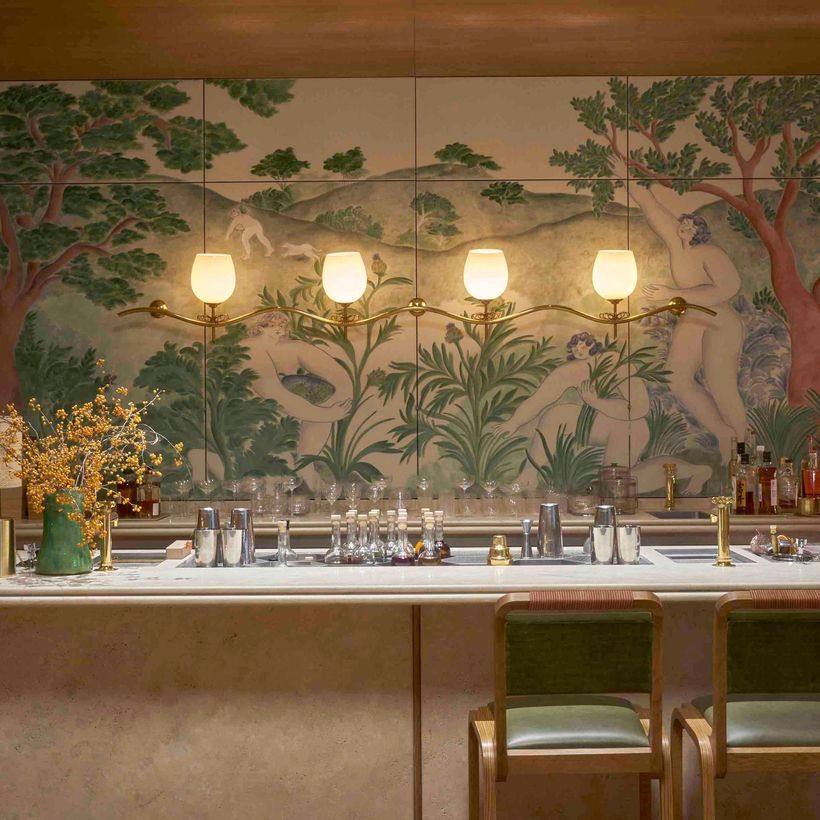San Francisco restaurants have taken multiple drubbings over the decades. Quince, however, has been almost all boom. What began as an overly ambitious neighborhood restaurant grew into its own constellation of stylish satellites, anchored by Quince’s three Michelin stars.
When Michael and Lindsay Tusk opened the first iteration of Quince in a Pacific Heights town house in 2003, they bootstrapped it with credit cards and parental assistance, bringing in their folks to help strip the floors and finesse the cozy décor. The couple had met while working at Paul Bertolli’s Oliveto, in Oakland—Lindsay in the dining room and Michael, who had also cooked at Chez Panisse and Stars, in the kitchen.

“We had no grand designs,” she recalls. “We were so thrilled when revenue was, like, $8,000.” It was a much simpler time to open a restaurant, she points out: There was no social media. Or Yelp. A chef as a brand wasn’t a thing.
They offered exceptional handmade pastas and an Italian-ish exploration of Northern California’s best ingredients. There was warmth emanating from the room and understated service that really did make you feel at home. This was fine-casual dining, perfect for a city that was then embracing fleece vests as power dressing. The immediacy of the food and hospitality, says Lindsay, cemented relationships that are still important. “If it wasn’t for our guests, we would not be where we are now, 100 percent,” she says.

(Those guests include the Gettys, Laurene Powell Jobs, and Sir Jony Ive, who credits the couple’s “remarkable expertise and breathtaking care” for their steady rise.)
With guest-investors and luck on their side, the couple was able to buy an 18,000-square-foot building in Jackson Square—a two-block pocket between the Financial District, North Beach, and Chinatown—in which they opened a supercharged Quince in 2009 and a more casual trattoria, Cotogna, down the hall in 2010.
The new Quince was an opulent pleasure craft, with Murano chandeliers and the couple’s photography collection lining the ebonized walnut paneling. The tasting menu bore what former San Francisco Chronicle critic Michael Bauer described as Michael Tusk’s emerging signature: artfully rustic-looking dishes that revealed intricate layers of refinement. Meanwhile, Cotogna’s pastas made it the most impossible reservation in town.
“We had no grand designs. We were so thrilled when revenue was, like, $8,000.”
When Bauer re-reviewed Quince in 2012, he wrote that the Tusks’ passion had catapulted the restaurant into the four-star stratosphere, comparing Michael’s tasting menu to Mozart’s “Paris” Symphony. The couple had already tweaked the dining room, menu, and service, a level of fine-tuning that has become one of their signatures, as much of an intuitive response to high-profile guests’ evolving needs for pageantry or privacy as it is a desire to keep playing with the design.

Rather than expand their empire to Vegas or Singapore, the Tusks embraced Jackson Square. (While studying at Berkeley, Lindsay, like Ive, discovered Jackson Square through William Stout’s architecture-and-design bookstore.) “Mike is the type of chef that needs to be in his restaurants,” Lindsay explains. (David Kinch, the former chef of three-Michelin-star Manresa, says admiringly, “Michael’s apron is dirty.”) So they opened the stylish French wine bar Verjus nearby and filled it with finds from the flea market, and they purchased Fresh Run Farm, in Bolinas, to supply the restaurants.
During the pandemic, the restaurant closed, and they spent more than a year at the farm, where they ran a Quince pop-up. The pandemic and its long tail have been challenging for business—40 percent of their clientele were out-of-towners—but it also deepened the Tusks’ commitment to San Francisco.
As part of the run-up to their anniversary, they spent almost a year renovating Quince with Jackson Square neighbor Steven Volpe (an interior designer) and up-and-coming Parisian architect Diego Delgado-Elias. Together, they flipped the layout and shrank the dining room, making the space brighter, softer, and more intimate. In response to fatigue with long tasting menus, they’ve added a four-course, $270 edit, as well as à la carte bites in the salon to encourage drop-ins. In many ways, it’s a return to the original.

If it feels like a home, that was the intention, says Lindsay: This time, they designed something that they would want to live in, since they practically do. “I probably wish I gave as much care to my own home as I do to that dining room!” she adds.
The Tusks are re-committing to the neighborhood too. They opened a private dining space above the Vesuvio bar, are debuting the Cotogna Gelato Shop come spring, and will have Verjus reopened by summer. Having such swish canteens has attracted creative studios to Jackson Square: Ive credits it as a substantial reason for opening his LoveFrom HQ there in 2019.
Asked what gives the Tusks such staying power, Ive says, “A clear sense of place. Their relationship with their farm. Their refined and sophisticated aesthetic. Their kindness and commitment to excellence.”
That commitment has been the couple’s only true strategy over the decades. “You don’t know what you don’t know,” Lindsay says of their Jackson Square journey. “I feel like we were pretty brazen and kind of had no business doing what we did, but we just went for it because it was such a good opportunity and such a lovely, charming neighborhood.”
Christine Muhlke, a former editor at The New York Times and Bon Appétit, is a co-author of Wine Simple, with Le Bernardin’s Aldo Sohm, and a co-author of Phaidon’s Signature Dishes That Matter. She is also the founder of culinary consultancy Bureau X and the creator of the Xtine newsletter


